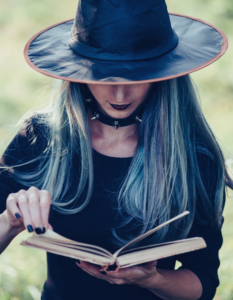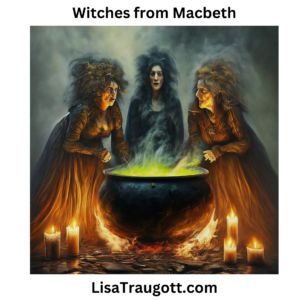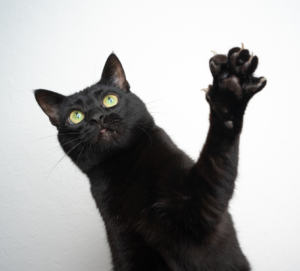Mystic Symbols: Unveiling the Secrets Behind Cats, Broomsticks, and Witch Hats
As a fiction writer, I do a lot of research into my characters, which means I’ve been studying up on witches.
Set in 1739, “To Rescue a Witch” is about an abused girl accused of witchcraft who must be rescued by a man married to… an actual witch. For Annaliese, the innocent accused of witchcraft, I did a deep dive into witch trials and the legal aspects supported by historical accounts. For Fiona, the actual witch, I researched Celtic pagan traditions, Scottish folklore and read histories about ‘wise women’, ‘healers’ and ‘cunning folk’.
It’s strange to think that people believed in witches but if you were born in a certain era witches were considered real. In today’s world, we see accused witches as vulnerable women (about 84% of the accused were female) but their peers saw them as powerful people to be feared, which was a concept that took me a while to wrap my head around. In future posts I’ll tell you some stories of the accused and the condemned, but today’s post will focus on the witch’s mystic symbols and some theories of their basis in history.
Pointy Black Hat
From the Wicked Witch of the West to popular Halloween costumes, nothing says ‘witch’ faster than a pointy black hat. There are a couple of theories hoe this fashion accessory became associated with witches.
In late medieval times it was fashionable for royal women to wear tall, conical hats called hennins. By the time peasants started wearing them, they became unfashionable and signified someone of lower status. Many of the women were social outcasts, so it stands to reason they would be dressed in older styled clothes.
Another theory has antisemitic roots. Throughout Europe Jews were marginalized and in some areas the law mandated they wear pointy hats. The Holy Roman Empire decreed in the Fourth Lateran Council in 1215 that Jews (and Muslims) must dress differently than Christians. Jews were often called ‘Christ killers’ and were associated with evil, much like accused witches.
Below is a painting of Süßkind_von_Trimberg, a German-Jewish poet wearing the ‘Jewish hat’. For further reading and paintings, check out this source: The Librarians – The Origin of the Jewish Hat
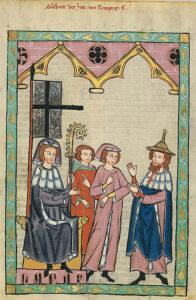
The third theory ties to beer. Really. Alewives (women who brewed and sold beer) tended to wear clothes that would stand out in a busy market (like black pointy hats) to make more sales. Beer making used to be considered a female job, but once men got into the business, it’s possible that misogyny and perhaps jealousy with a more successful business woman could have played a part in associating evil doing with these women and their pointy hats.
Broomsticks
In pagan rituals, a broomstick was sometimes used as part of a cleansing ritual, to sweep away bad spirits. But perhaps the association of broomsticks to witchcraft had more to do with legal testimony. During numerous witch hunts, the accused person was tortured and sleep-deprived until they would confess. Side note – sleep deprivation could cause hallucinations and often times people being tortured will say whatever it takes to stop the pain. Whatever the reason, many confessions of condemned witches included descriptions of flying on a broomstick. Woodcuts, illustrations and pamphlets reflected such testimony. Below is a 1720 woodcut from a book about the history of witches.
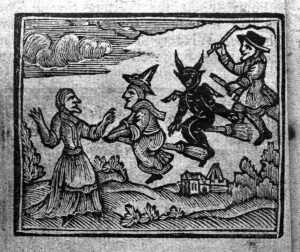
Healing Herbs
In the past, there was a fine line between magic and science. ‘Good witches’ were also known as healers, wise women and cunning folk because they knew the medicinal uses of certain herbs. In “To Rescue a Witch” there is a scene where Fiona goes through her grimoire (Book of Spells) and looks at drawings of herbs and their healing properties.
“Fiona extracted her wooden box hidden under the floorboard beneath the bed. Gently blowing away fifteen years of dust on the lid, she gingerly unearthed her leather-bound grimoire. True, she told William ages ago she had burned it, but how could she? It was the first thing she created once William taught her to read and write. Her fingers caressed the recipes for spells, and she sighed at her detailed herb diagrams with their uses. Rosemary to ward off evil spirits. Sage for treating fevers. Pennyroyal to provoke the menses.”
Cauldrons
While cauldrons are associated with concocting evil spells, let’s keep it real and consider that just about every home held a cast iron cauldron or a copper pot to make stew over the hearth. The alewives noted above also had plenty of cauldrons to make their beer, so this was another strike against them. However cauldrons became associated with witches, there are plenty of examples of the symbol in literature.
In William Shakespeare’s Macbeth, Act IV, scene 1, is a famous scene where the witches are adding ingredients to a boiling cauldron to make a potion.
“Double, double, toil and trouble; Fire burn and cauldron bubble.”
Black Cats
“Familiars” can be furry friends like cats, dogs and mice or feathered friends like owls or slimy friends like frogs and toads. Ribbit. What make these animals so appealing to witches? Apparently, once a witch signs a pact with the Devil she is given an animal companion to help her make mischief. It was believed that witches could shape-shift into one of their familiars to wreak havoc on neighbors and then escape without detection.
In my current work in progress, “To Reclaim a Witch,” Fiona’s aunt Matilda (who was burned at the stake for witchcraft) often appears as a black cat. While Matilda isn’t evil, she certainly enjoys wreaking havoc!
Now that we’ve covered the basics, what other witchy things are you interested in hearing about? I’d love your feedback for future posts.
Lisa 😉

Copyright (c) Lisa Traugott 2024. All rights reserved.
